"Cooking with the local grannies" by the season
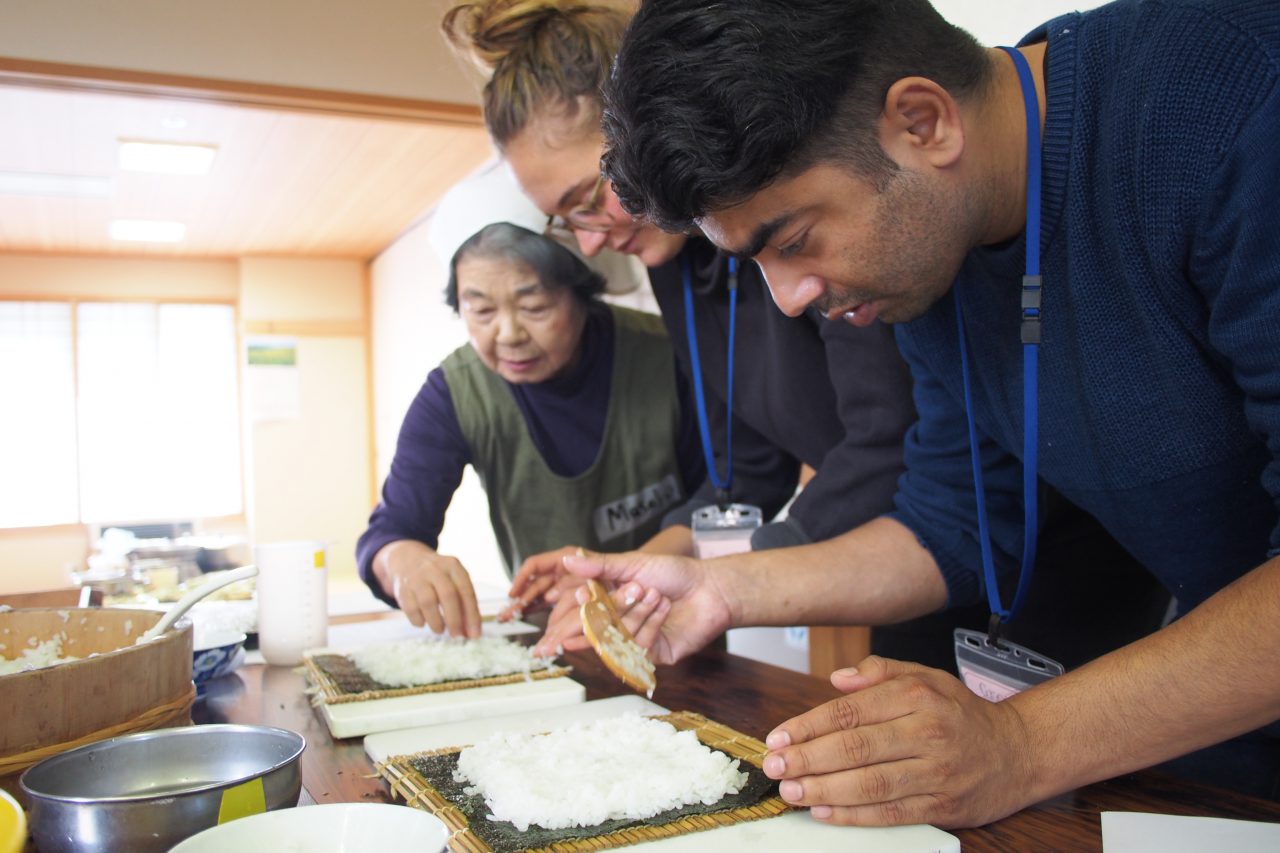
In the Yamaura, the rural area in the foothills of the Yatsugatake Mountains, the food culture is attuned to the land and its seasons. The locals still lead a life in harmony with nature, adapting their farming activities and eating habits to the climate.
As the region is located at an elevation of about 1,000m, this also means embracing piercingly cold winters that last for many months. Even in the summer, the significant temperature gap between day and night prevents farmers from growing certain vegetables and fruits. A life so close to the mountains is not always idyllic, but the locals have found ways to thrive over the centuries by making the best of the distinctive climate and definite seasons.
The local gastronomy, which developed under these circumstances, is filled with generations’ wisdom. Let’s delve into the local culture one bite at a time.
SPRING (April ~June)
Spring is the time when the locals rely most on the mountain’s blessings. After a long winter that has dragged on for months, weather slowly gets warmer and nature comes back to life. In the early mornings and evenings, though, it is still cold and snowfalls may happen as late as the first week of May. This means that seeds and seedlings cannot be planted until well into May, and the first vegetables cannot be harvested until the end of June.
While they wait for the fields to bear the first crops, farmers forage the woods surrounding the villages in search of wild vegetables such as fuki, seri, koshi-abura and more. These wild veggies that in Japan are called “sansei” are the protagonists of spring dishes.
Sansai shoots are slightly bitter and a little astringent, but if cooked in the right way, they can be delicious. Foraging must be done parsimoniously, though, making sure to leave enough for the plants to survive and bud again the following year.
SPRING SEASONAL TASKS
Every “Cooking with the grannies” activity starts with a seasonal task, so that you can have a taste of the season even before you start eating. As for spring, the seasonal task will certainly involve some foraging. What you are going to gather depends on the period you visit, as wild vegetables do not bud at the same time. At the beginning of April, you will find fukinoto buds (butterbur shoots), while toward the end of the month, you may find seri (dropwort), nenbiro (a wild rocambole), and gyojya ninniku (alpine leek). May is the time for kogomi (ostrich fern), koshi-abura, and warabi (bracken). Finally, in June you will most definitely pick fuki and tobuki (butterbur and giant butterbur), the grown-up versions of fukinoto.
SPRING MENU (example)
・Ki-no-me Takikomi Gohan
Takikomi Gohan is a rice dish seasoned with dashi broth and soy sauce along with various other ingredients such as vegetables of meat. In this case, the rice is mixed with ki-no-me, the bud sprouts of the Japanese spindle tree.
・Nenbiro Miso Soup
Delicious miso soup made with homemade miso paste and nenbiro (wild rocambole) shoots
・Fuki-miso
A savory side dish made by mixing miso paste and fukinoto (butterbur shoots)
・Sansai Tempura
Crispy wild vegetable tempura
・Yomogi Mochi
Green rice cakes where a wild veggie named yomogi (mugwort) is pounded together with the rice.
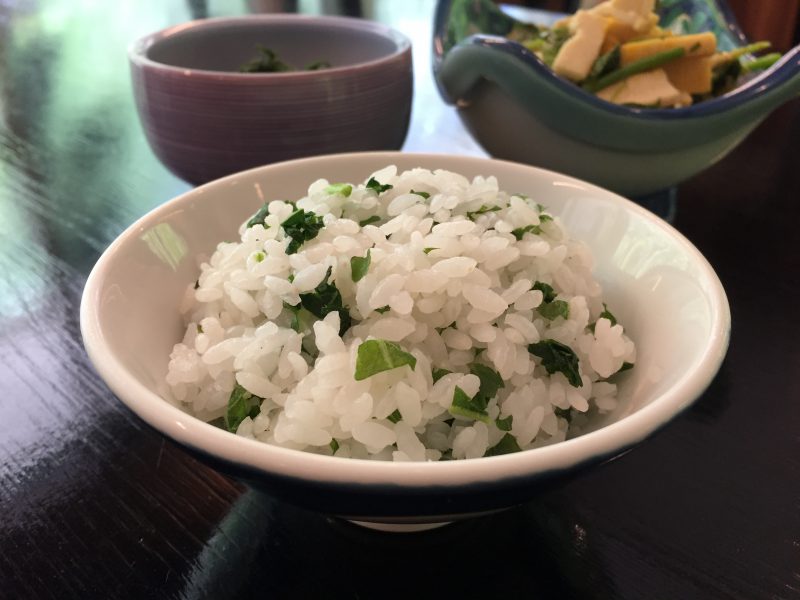
Ki-no-me Takikomi Gohan

Wild vegetable tempura
Fuki-miso
From one of our grannies’ memory:
When she was a child, Sumiko-san was tasked with gathering seri every time they expected guests. The best seri grows on the bed of mountain streams and waterways, which means she often had to put her feet in the water while searching. The water of mountain streams, which is cold even in the summer, is short of freezing in spring. Her job was no walk in the park, but showing off the basket full of seri to her family always made it worthwhile.
SUMMER (July ~early September)
Summer is a bountiful season rich in fresh and tasty vegetables. The long wait has come to an end, and all the work in the fields of the previous months has borne fruit.
The crops grown in the highland at over 1,000m and irrigated with water from pristine mountain streams are sweeter than regular vegetables and beans and have are full of flavor. This is the time of year when you can enjoy edamame beans, cucumbers, eggplants, celeries, etc. from field to table.
SUMMER SEASONAL TASKS
If your trip happens to fall in the summer, chances are you will get to go vegetable picking. Here, every villager has its own vegetable field and that includes our grannies. Before you start cooking, you can walk together to the field and grab all the veggies you need for your meal. There are no fresher ingredients.
Another task typical of this season is kampyo making. Kampyo is a preserved food made of dry gourd shavings. It is quite a common ingredient in Japan where it is used as a filling for sushi rolls, but in this day and age handmade kampyo is a rarity. Not in the Yamaura area, though. Here, it is an integral part of local culture, so much so that every household owns a special cutting board with a groove on it just for kampyo making. In case your task is kampyo making, you will receive an oblong gourd named yugao which you will peel, cut into thick slices first, and into thin shavings later. The shavings are then hung to dry under the sun, and since it takes a few weeks before they are ready, you cannot bring your kampyo back home. The grannie will give you some from last year, though, if you wish.
SUMMER MENU (example)
・Nota Mochi
Countryside-style rice cakes with savory edamame sauce
・Yugao and Myoga Miso Soup
Miso soup made with homemade miso paste and yugao gourd and Japanese wild ginger.
For this soup, we use the yugao leftovers from the kampyo making.
・Cabbage and dry squid pickled with salt
Pickle culture is very strong in the region. While in autumn food is “deep-pickled” for weeks or months, in summer food is “shallow-pickled” for a few hours.
Dry squid may seem out of place in a traditional dish from the mountainside, but it is a remnant of old days when the only fish that reached the region was either dry or salted.
・Grilled eggplant with miso sauce
A typical dish that combines seasonal vegetables with miso, the region’s most popular seasoning. Miso is, of course, homemade.
・Salad Tenyose (=agar cake)
Tenyose is a jelly-like cake made with agar-agar, which can be sweet or savory.
The Yatsugatake area boasts the most extensive production of natural agar in all Japan. Agar cakes are a local specialty served during festivals, weddings, and every other occasion.
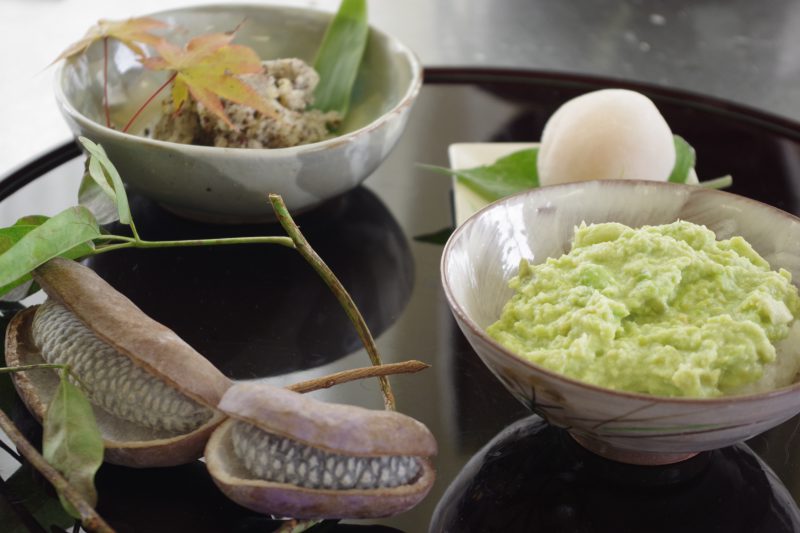
Nota mochi
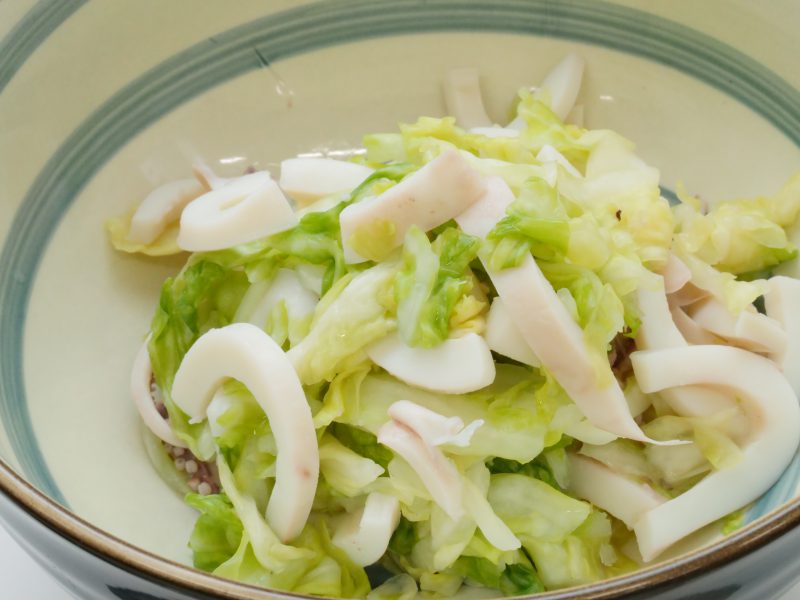
Cabbage and dry squid pickled with salt
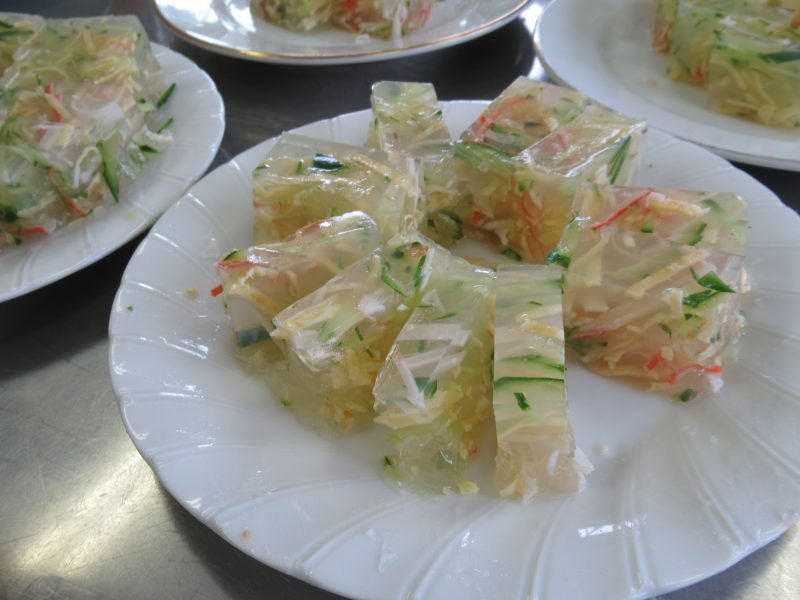
Salad Tenyose
From one of our grannies’ memory:
We used to plant soybeans on the banks of rice fields. We made it a point to put every single centimeter of land to use.
Toward the end of August, when most of the summer work had ended, we would pick the soybeans that were still green and make them into nota mochi. My dad liked the sauce savory, so we only used salt for seasoning, but many families who liked it sweet would add a good deal of sugar as well. It was a reward we gave ourselves for the hard work we did up to that point. I always looked forward to being able to eat nota mochi.
AUTUMN (late September ~November)
The first half of autumn is the season of harvest, while the second half is dedicated to the making of preserves for winter.
Toward the end of September, rice plants turn a glowing golden color indicating that they are ready to be reaped. But rice is not the only crop to be harvested in the Yamaura, soba (buckwheat), egoma (perilla), beans, hozuki (Chinese lanterns), and vegetables that grow underground such as daikon and potatoes are also in season.
The period after the harvest is just as busy, as the food in excess must be taken care of in view of the long winter ahead. The method of preservations in the area are almost endless. There is sun-drying, pickling (with salt, miso, rice bran, soy sauce, rice vinegar, or even a mix of all them), storing inside the ground, and even dry-freezing.
AUTUMN SEASONAL TASKS
There are just so many tasks you could experience in autumn.
Let’s say you join the activity in September or early October. Among other things, you might harvest soybeans or pick some sweet hozuki. One of the most representative tasks of this season, though, revolves around egoma, fragrant perilla grains that look like sesame.
If your menu includes egoma mochi, you will start the activity by beating the dry plants with a stick, then use a fan to separate the grains from the dirt.
If you instead do the experience toward the end of October or November, your tasks will most definitely involve preserved food. Perhaps you will make dry persimmons or pickle some daikon.
AUTUMN MENU (example)
・Vegetarian Sushi Rolls with Kampyo and Vegetables
Vegetarian sushi rolls are a local specialty prepared during the harvest festival.
The kampyo prepared in the summer comes in handy on this occasion.
・Jikobo Mushrooms Miso Soup
Autumn is also wild mushroom season, and many locals forage the woods in search of Jikobo.
・Japanese leeks and Root Vegetables stew
・Shimauri gourd pickled with sake lees
Shimauri is a small striped gourd known as oriental melon. Sake lees are a popular ingredient in the region, as there are over nine breweries.
・Kohaku Kanten (=red and white agar cake)
As we explained before, agar cakes are a must-eat dish in the Yamaura. Kohaku agar cakes, which are made with tofu, soy sauce, and walnuts, are often served for celebrations as the red and white colors are considered auspicious in Japan.
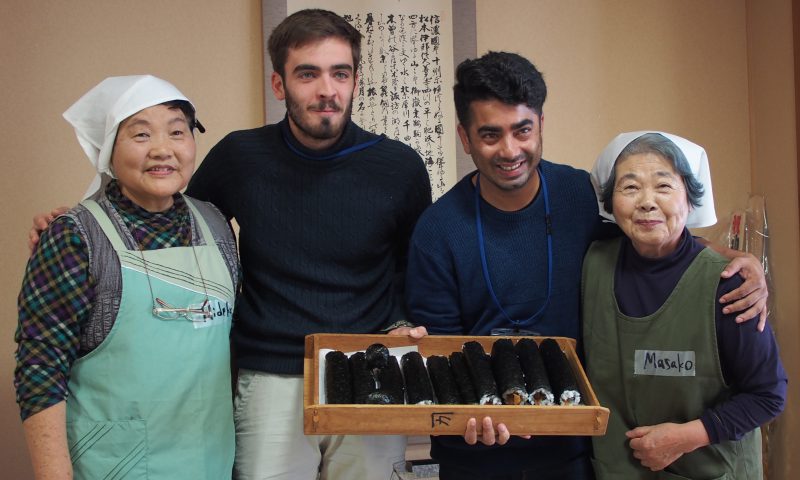
Vegetarian Sushi Rolls with Kampyo and Vegetables
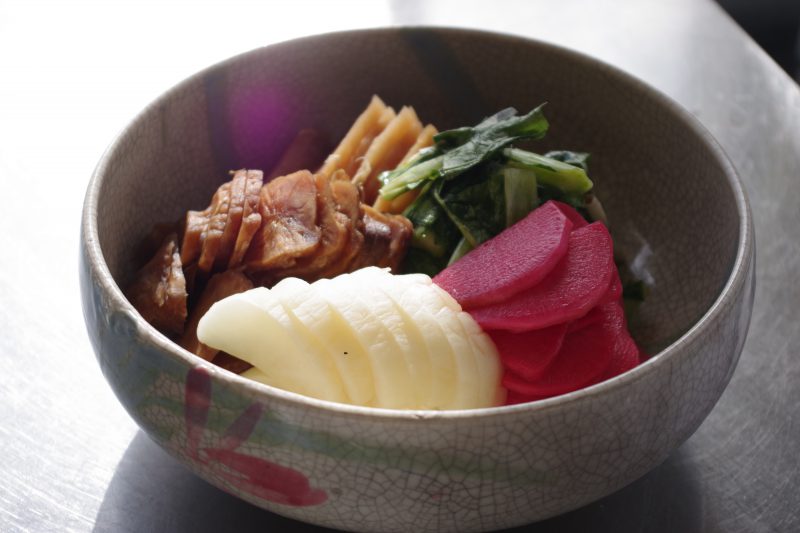
Pickles

Kohaku kanten
From one of our grannies’ memory:
In autumn, many households in the Yamaura lay vegetables out in the sun to preserve them till spring. When she was a child, Hideko-san would sneak a couple of the drying pumpkin slices to eat on the way to school. Her mother would pretend not to notice, even though she could hardly have missed the sizeable lack of pumpkin by the end of the season.
WINTER (December ~March)
Winter is the most characteristic of all four seasons. It begins as early as December when the temperatures at night start dropping below zero and drag on for four months until the end of March. Being uncommonly long is not the only reason why local winters stand out so much. What is most astounding about this season is the glacial temperatures that may reach minus 20 degrees. Snow is scarce in the foothills of the Yatsugatake, but frost abounds.
With such freezing weather, farming is, of course, out of the question. The last vegetables, mainly turnips, are picked in early November, then nothing goes on in the fields until the spring. However, local farmers are just as active as any other season. Here, the cold mountain breeze is used to produce some distinctive preserved foods such as kanten (agar-agar), frozen tofu, frozen daikon, and frozen mochi.
Winter is also a time to make miso paste, a one-year-long endeavor that begins with mixing mashed soybeans, koji rice, and salt.
WINTER SEASONAL TASKS
As you can guess, most winter tasks are about preparing freeze-dried preserves foods. If you are staying in the heart of winter, you will have the chance to experience making frozen daikon or frozen mochi. The scenery of white daikon slices hanging frozen from rice straw ropes is almost unique to the Yamaura region.
March, on the other hand, is almost entirely dedicated to miso making. Miso is one of Japan’s most famous ingredient, and you most likely have eaten it at least once. However, making it with your own hands is something even most Japanese people have never experienced. On top of being a once-in-a-lifetime experience, this task also allows you to bring back home some miso as a souvenir.
WINTER MENU (example)
・Abura-e Mochi
Countryside-style rice cake with fragrant perilla sauce
・Egg-drop Soup with Frozen Tofu
Miso soup made with handmade miso and frozen tofu, completed by adding egg at the end
・Frozen Daikon Stew
Japanese stew made with frozen daikon and other root vegetables
・Nozawana Pickles
A typical dish from Nagano made with pickled turnip leaves
・Soy Milk and Strawberry Tenyose (=agar cake)
No menu is complete without an agar cake. Strawberry agar cakes are favorite winter desserts.
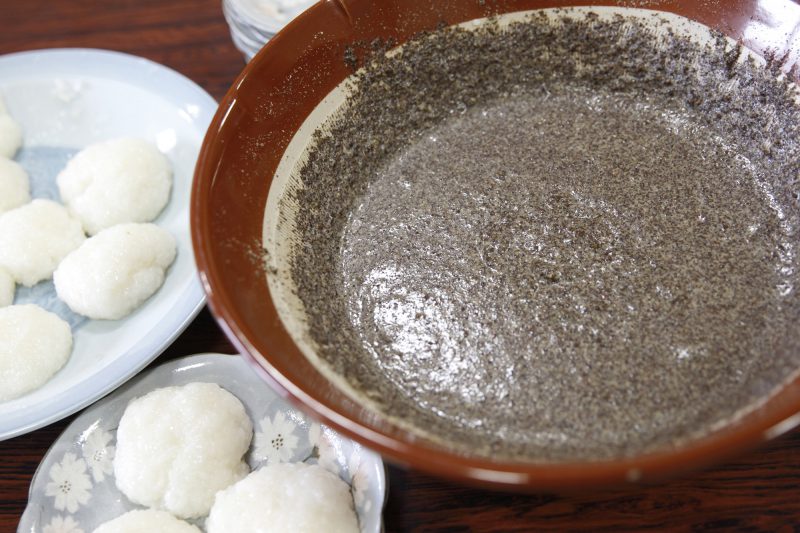
Abura-e mochi

Egg-drop Soup with Frozen Tofu
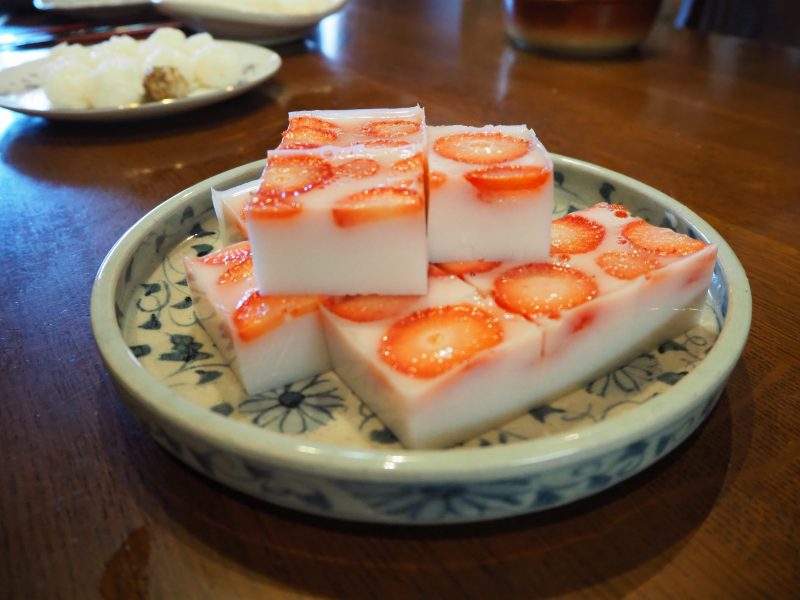
Strawberry and milk tenyose
From one of our grannies’ memory:
In February, this granny’s mum used to make frozen mochi. The rice cakes were laid outside to freeze and dry for several days until they reached the consistency of crackers. The granny as a kid, though, did not like waiting and would steal a few cakes while they were still frozen to eat them while sitting in the warmth of the hori-gotatsu, a low table placed over burning charcoals.
Take a journey off the gastronomy beaten track
Take a journey off the gastronomy beaten track
Sushi, ramen, and tempura are great, but if you want to go off the gastronomy beaten track and explore a more intimate side of Japanese cuisine, this is the activity for you. You can experience authentic rural Japan, visit a nostalgic farming village, and try new delicious flavors.
Oh, and you can learn from the best, the local grannies.
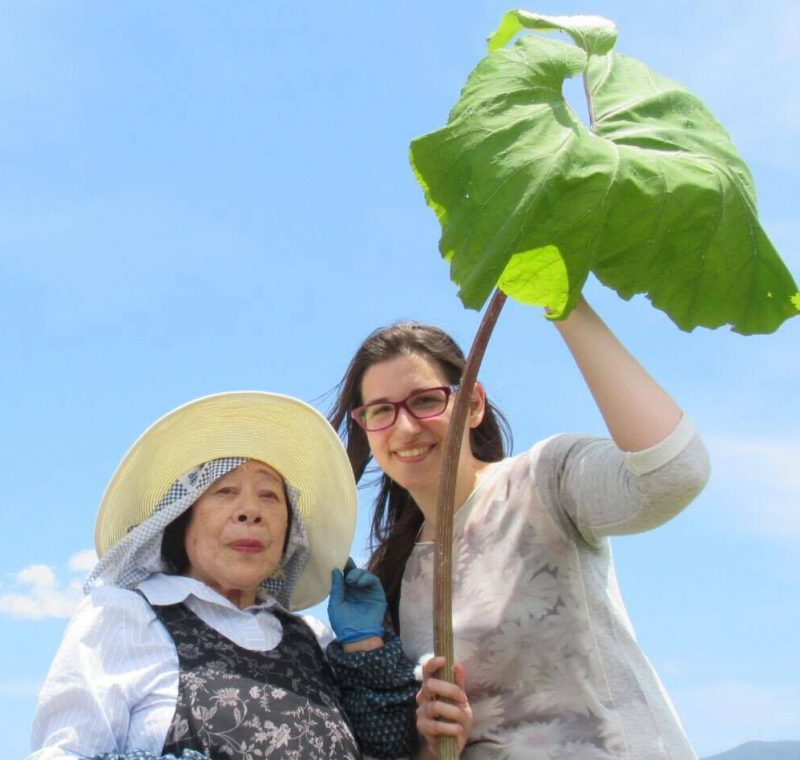
Cristina


